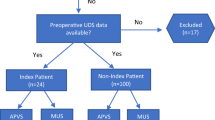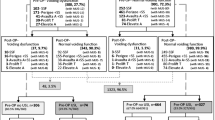Abstract
We set out to identify predictors of successful voiding immediately after outpatient mid-urethral sling. The charts of 126 patients who underwent an outpatient mid-urethral sling procedure were identified. Using discharge without a urinary catheter as the dependent variable, logistic regression analysis modeled the relationship of independent variables including demographic, preoperative urodynamic, and perioperative variables. Sixty-one percent of the patients passed their immediate postoperative voiding trial. Logistic regression analysis revealed that parity ≥3, Valsalva leak point pressure >60 cm H2O, and high preoperative anxiety remained independently associated with successful voiding. Identifying preoperative variables that are associated with successful voiding after mid-urethral sling may be useful in helping to accurately shape patient expectations and identify those most likely to benefit from preoperative teaching of self-catheterization.
Similar content being viewed by others
References
Hampel C, Artibani W, Espuna Pons M, Haab F, Jackson S, Romero J, Gavart S, Papanicolaou S (2004) Understanding the burden of stress urinary incontinence in Europe: a qualitative review of the literature. Eur Urol 46:15–27
Minaire P, Jacquetin B (1992) The prevalence of female urinary incontinence in general practice. J Gynecol Obstet Biol Reprod (Paris) 21:731–738
Sze EH, Jones WP, Ferguson JL, Barker CD, Dolezal JM (2002) Prevalence of urinary incontinence symptoms among black, white, and hispanic women. Obstet Gynecol 99:572–575
Brown JS, Grady D, Ouslander JG, Herzog AR, Varner RE, Posner SF (1999) Prevalence of urinary incontinence and associated risk factors in postmenopausal women. Heart and estrogen/progestin replacement study (HERS) research group. Obstet Gynecol 94:66–70
Alcalay M, Monga A, Stanton SL (1995) Burch colposuspension: A 10–20 year follow up. Br J Obstet Gynaecol 102:740–745
Nilsson CG, Falconer C, Rezapour M (2004) Seven-year follow-up of the tension-free vaginal tape procedure for treatment of urinary incontinence. Obstet Gynecol 104:1259–1262
Mutone N, Brizendine E, Hale D (2003) Factors that influence voiding function after the tension-free vaginal tape procedure for stress urinary incontinence. Am J Obstet Gynecol 188:1477–1481 (discussion 1481–1473)
Al-Badr A, Ross S, Soroka D, Minassian VA, Karahalios A, Drutz HP (2003) Voiding patterns and urodynamics after a tension-free vaginal tape procedure. J Obstet Gynaecol Can 25:725–730
Minassian VA, Al-Badr A, Drutz HP, Lovatsis D (2004) Tension-free vaginal tape, burch, and slings: are there predictors for early postoperative voiding dysfunction? Int Urogynecol J Pelvic Floor Dysfunct 15:183–187
Mishra VC, Mishra N, Karim OM, Motiwala HG (2005) Voiding dysfunction after tension-free vaginal tape: a conservative approach is often successful. Int Urogynecol J Pelvic Floor Dysfunct 16:210–214 (discussion 214)
Cetinel B, Demirkesen O, Onal B, Akkus E, Alan C, Can G (2004) Are there any factors predicting the cure and complication rates of tension-free vaginal tape? Int Urogynecol J Pelvic Floor Dysfunct 15:188–193
Bodelsson G, Henriksson L, Osser S, Stjernquist M (2002) Short-term complications of the tension-free vaginal tape operation for stress urinary incontinence in women. BJOG 109:566–569
Hong B, Park S, Kim HS, Choo MS (2003) Factors predictive of urinary retention after a tension-free vaginal tape procedure for female stress urinary incontinence. J Urol 170:852–856
Karram MM, Bhatia NN (1988) The q-tip test: standardization of the technique and its interpretation in women with urinary incontinence. Obstet Gynecol 71:807–811
Meschia M, Pifarotti P, Bernasconi F, Guercio E, Maffiolini M, Magatti F, Spreafico L (2001) Tension-free vaginal tape: analysis of outcomes and complications in 404 stress incontinent women. Int Urogynecol J Pelvic Floor Dysfunct 12(Suppl 2):S24–S27
Wang AC, Chen MC (2003) The correlation between preoperative voiding mechanism and surgical outcome of the tension-free vaginal tape procedure, with reference to quality of life. BJU Int 91:502–506
Ulmsten U, Henriksson L, Johnson P, Varhos G (1996) An ambulatory surgical procedure under local anesthesia for treatment of female urinary incontinence. Int Urogynecol J Pelvic Floor Dysfunct 7:81–85 (discussion 85–86)
Pavlin DJ, Pavlin EG, Gunn HC, Taraday JK, Koerschgen ME (1999) Voiding in patients with or without ultrasound monitoring of bladder volume after outpatient surgery. Anesth Analg 89:90–97
Gaynes BI, Barkin RL (1999) Analgesics in ophthalmic practice: a review of the oral non-narcotic agent tramadol. Optom Vis Sci 76:455–461
Abrams P, Cardozo L, Fall M, Griffiths D, Rosier P, Ulmsten U, Van Kerrebroeck P, Victor A, Wein A (2003) The standardization of terminology in lower urinary tract function: report from the standardization sub-committee of the international continence society. J Urol 61:37–49
Klutke C, Siegel S, Carlin B, Paszkiewicz E, Kirkemo A, Klutke J (2001) Urinary retention after tension-free vaginal tape procedure: incidence and treatment. J Urol 58:697–701
Paick JS, Ku JH, Shin JW, Son H, Oh SJ, Kim SW (2004) Tension-free vaginal tape procedure for urinary incontinence with low Valsalva leak point pressure. J Urol 172:1370–1373
Nitti VW, Combs AJ (1996) Correlation of Valsalva leak point pressure with subjective degree of stress urinary incontinence in women. J Urol 155:281–285
Grodstein F, Fretts R, Lifford K, Resnick N, Curhan G (2003) Association of age, race, and obstetric history with urinary symptoms among women in the nurses’ health study. Am J Obstet Gynecol 189:428–434
Rortveit G, Hannestad YS, Daltveit AK, Hunskaar S (2001) Age- and type-dependent effects of parity on urinary incontinence: the Norwegian EPINCONT study. Obstet Gynecol 98:1004–1010
Handa VL, Harvey L, Fox HE, Kjerulff KH (2004) Parity and route of delivery: does cesarean delivery reduce bladder symptoms later in life? Am J Obstet Gynecol 191:463–469
Handa VL, Harris TA, Ostergard DR (1996) Protecting the pelvic floor: obstetric management to prevent incontinence and pelvic organ prolapse. Obstet Gynecol 88:470–478
Sokol AI, Jelovsek JE, Walters MD, Paraiso MF, Barber MD (2005) Incidence and predictors of prolonged urinary retention after TVT with and without concurrent prolapse surgery. Am J Obstet Gynecol 192:1537–1543
Author information
Authors and Affiliations
Corresponding author
Rights and permissions
About this article
Cite this article
Barron, K.I., Savageau, J.A., Young, S.B. et al. Prediction of successful voiding immediately after outpatient mid-urethral sling. Int Urogynecol J 17, 570–575 (2006). https://doi.org/10.1007/s00192-005-0064-8
Received:
Accepted:
Published:
Issue Date:
DOI: https://doi.org/10.1007/s00192-005-0064-8




